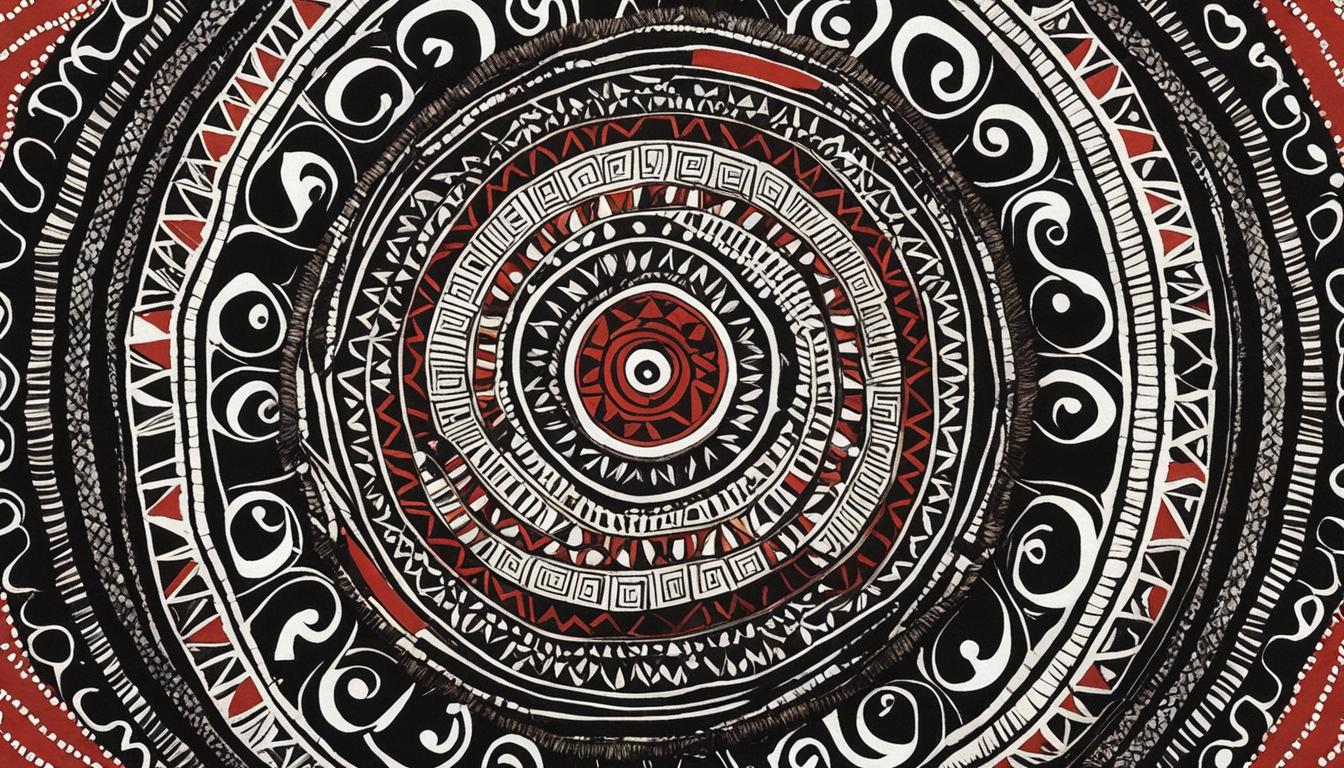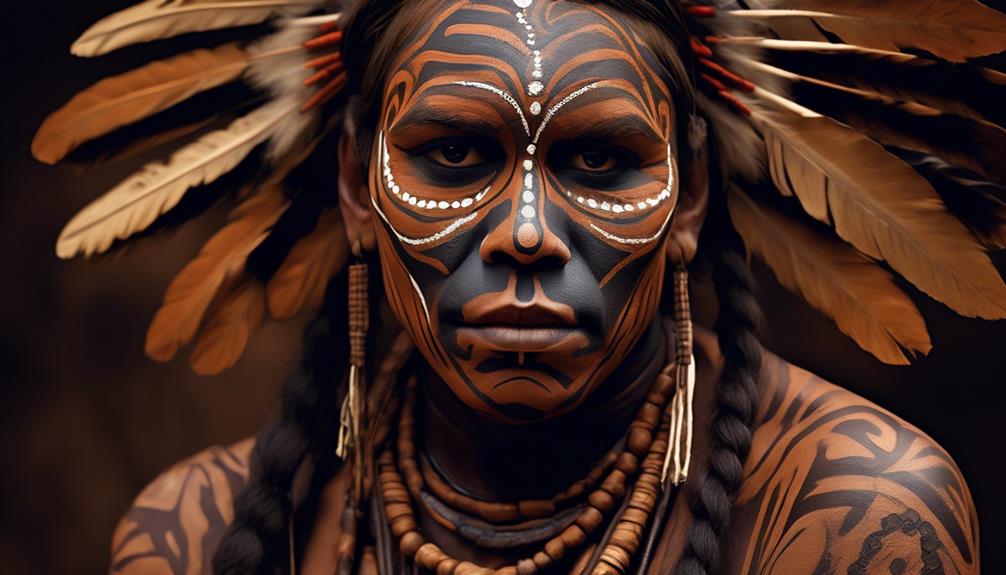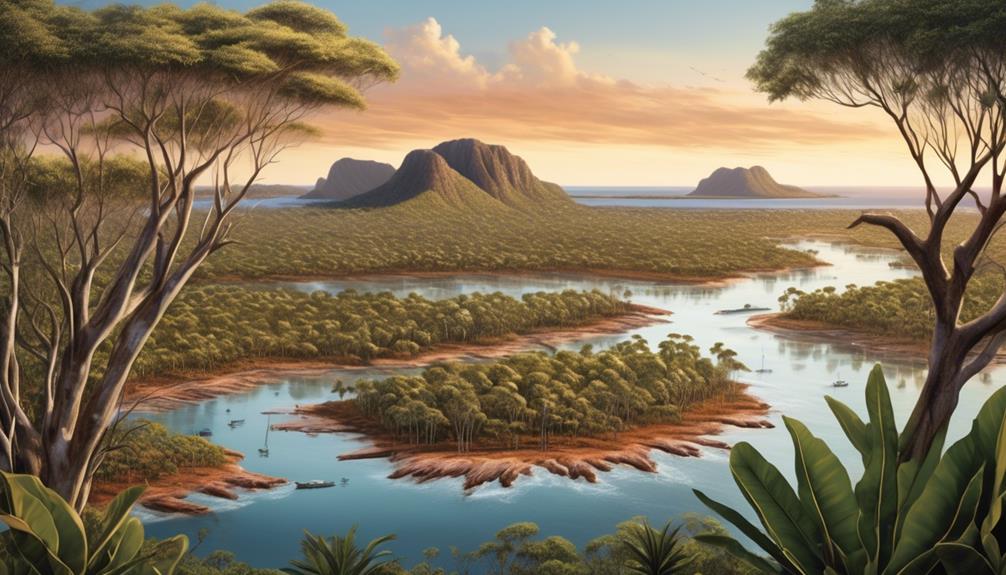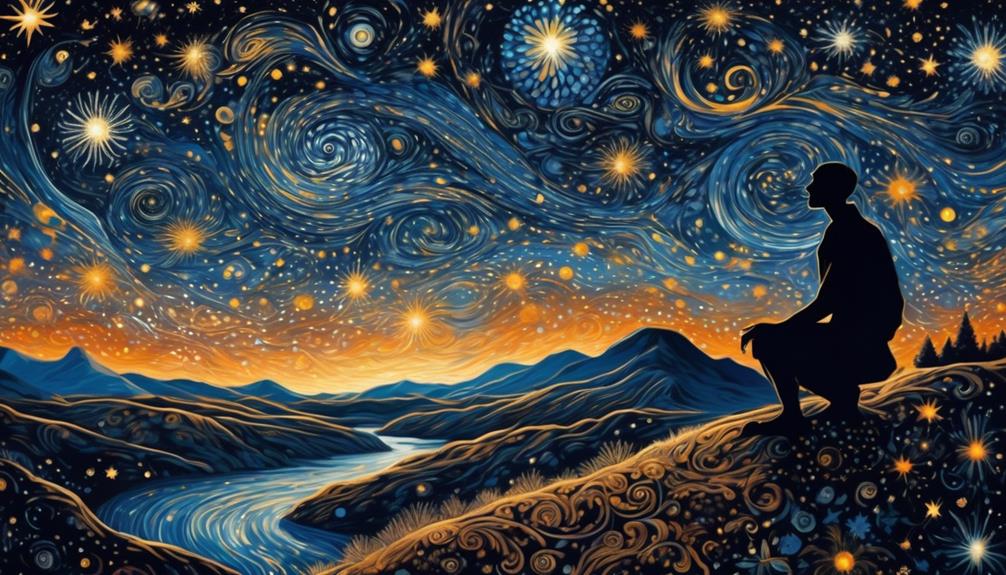Hello! Today we are embarking on a fascinating journey to unravel the intricate mosaic of Aboriginal identity in Australia. By delving into this vast and varied topic, our goal is to discover the true essence of what it means to be Aboriginal, the historical significance, and the importance of this identity. Join us as we delve into the cultural core that shapes the existence of Indigenous communities.
Key Takeaways:
- Aboriginal identity is complex and encompasses the history, rights, and cultural significance of Aboriginal people in Australia.
- Understanding Aboriginal identity requires exploring their enduring relationship with the land, the challenges they have faced, and the importance of self-identification within the community.
- The definition of Aboriginal identity includes having Aboriginal or Torres Strait Islander descent, self-identification as Aboriginal, and acceptance by the community.
- Aboriginal people face challenges in defining their identity due to historical factors, societal issues, and differing opinions within the community.
- Cultural connection plays a vital role in Aboriginal identity, going beyond skin color to encompass shared experiences, cultural practices, and a profound connection to the land.
The History of Aboriginal People in Australia
When exploring the rich tapestry of Australian culture, it is impossible to ignore the profound history of the Aboriginal people. Their story is one of resilience, survival, and a deep connection to the land. Understanding the history of Aboriginal people in Australia allows us to appreciate the enduring legacy of indigenous culture and the significance of native communities.
The history of Aboriginal people in Australia is marked by a series of challenges and hardships. With the arrival of European settlers in the late 18th century, the lives of Aboriginal communities were forever altered. Invasion, violent conflicts, and forced removal from ancestral lands disrupted their way of life and threatened their existence.
“The impact of colonization on Aboriginal people cannot be underestimated. It has resulted in a long-lasting trauma that continues to shape their lives and the preservation of their cultural heritage.”
As European settlers established colonies, Aboriginal communities were subjected to policies aimed at assimilation and control. The introduction of new diseases further devastated these communities, leading to a significant decline in population. Despite these immense challenges, the connection between Aboriginal people and the land remained resilient.
In the midst of adversity, Aboriginal culture persevered. The deep spiritual and cultural significance of the land within indigenous communities allowed them to maintain their identity, traditions, and connection to their ancestral territories. Aboriginal people possess a unique understanding of the environment, which has been passed down through generations, forming the bedrock of their cultural practices and rituals.
Today, Aboriginal communities continue to assert their rights and fight for recognition and reconciliation. The ongoing journey towards acknowledging the historical and cultural significance of Aboriginal people and their contributions to Australian society is essential for fostering an inclusive and diverse nation.
In the next section, we will explore the definition of Aboriginal identity and the complexities surrounding its interpretation.
The Definition of Aboriginal Identity
Understanding what it means to be Aboriginal is central to appreciating the rich tapestry of indigenous culture in Australia. The current Australian definition of Aboriginal identity comprises several key components:
- Aboriginal or Torres Strait Islander Descent: Having ancestral ties to Aboriginal or Torres Strait Islander heritage forms the foundation of Aboriginal identity. It recognizes the deep-rooted connection to native communities and ancestral lands.
- Self-Identification as Aboriginal: Embracing one’s Aboriginal heritage and acknowledging it as an integral part of one’s identity is a crucial aspect of being Aboriginal. It encompasses a sense of belonging and pride in indigenous culture and traditions.
- Acceptance by the Community: Aboriginal identity is affirmed by acceptance from the Aboriginal community. This signifies recognition and validation from fellow Aboriginal people, acknowledging an individual’s cultural ties and contributions.
This definition, developed by the Commonwealth Department of Aboriginal Affairs, provides a framework for understanding Aboriginal identity. However, it is important to note that defining Aboriginal identity can be complex and sometimes contested, reflecting the diversity and individuality within the Aboriginal community.
The Definition of Aboriginal Identity
| Component | Description |
|---|---|
| Aboriginal or Torres Strait Islander Descent | Having ancestral ties to Aboriginal or Torres Strait Islander heritage |
| Self-Identification as Aboriginal | Embracing Aboriginal heritage as an integral part of one’s identity |
| Acceptance by the Community | Affirmation and recognition from the Aboriginal community |
Challenges Faced by Aboriginal People in Defining Their Identity
Aboriginal people navigate a complex and challenging journey in defining their identity, grappling with the enduring effects of historical and societal factors. The legacy of colonization and racism, coupled with the diversity of opinions within the community, pose significant obstacles to a clear understanding and self-identification.
For generations, Aboriginal people have endured the effects of colonization, which have disrupted the continuity of their cultural practices, language, and sense of identity. The imposition of Western structures and values has led to a sense of disconnection and cultural dislocation among many Aboriginal individuals and communities.
Moreover, racism continues to be a barrier to defining and affirming Aboriginal identity. Prejudices and stereotypes perpetuated by society can undermine self-esteem, causing doubt and confusion among Aboriginal people as they strive to embrace their heritage and assert their identity.
Within the Aboriginal community, differing perspectives on what constitutes Aboriginality can create further challenges. The complexity of Aboriginal culture, with its diverse languages, knowledge systems, and spiritual beliefs, prompts discussions and debates about who should be recognized as Aboriginal. These debates often center on questions of lineage, connection to country, and cultural knowledge.
“I think one of the biggest challenges we face when trying to establish our Aboriginal identity is the societal pressure to fit into a narrow box. But our identity is so much more than just blood quantum or specific cultural practices. It’s about our connection to the land, our history, and the ongoing fight for justice.” – Jasmine, Aboriginal artist and activist
Despite these challenges, the right to self-identify and define one’s own Aboriginality is fundamental. The United Nations Declaration on the Rights of Indigenous Peoples recognizes the importance of self-determination and cultural autonomy. It affirms that individuals have the right to identify as Aboriginal based on their own sense of belonging, irrespective of external validation or strict ancestral criteria.
The Importance of Cultural Connection for Aboriginal Identity
For Aboriginal people, cultural connection is at the core of their identity. It goes beyond skin color and is shaped by a shared experience, cultural practices, and a deep connection to the land. Aboriginality encompasses a profound philosophical set of rules rooted in respect for the natural world and a recognition of the importance of living in harmony with it.

Indigenous Australians have a rich and diverse cultural heritage that has been passed down through generations. Traditional custodianship is a fundamental aspect of their identity, with Aboriginal people considering themselves as caretakers of the land and its resources. This stewardship reflects their deep respect for the environment and their commitment to preserving it for future generations.
Cultural practices, such as ceremonies, storytelling, art, and dance, are integral to maintaining and strengthening Aboriginal identity. They play a crucial role in passing down knowledge, maintaining social cohesion, and reinforcing a sense of belonging within the community. These practices provide a tangible link to their ancestors and traditions, reinforcing their indigeneity.
“Our connection to the land and our cultural practices define who we are as Aboriginal people. It is through our customs and traditions that we find strength, resilience, and a profound sense of self.”
Indigenous Australians have faced significant challenges throughout history, including colonization, forced assimilation, and the erosion of their cultural practices. However, the deep-rooted connection to their culture has served as a source of resilience and strength. It has allowed Aboriginal people to navigate the complexities of identity and reclaim their heritage, despite ongoing barriers and discrimination.
Preserving Cultural Connection
Recognizing and supporting Aboriginal cultural connection is vital for the well-being and self-determination of Indigenous communities. Efforts are being made to ensure the preservation and revitalization of cultural practices, language, and traditional knowledge. This includes initiatives such as land rights, cultural education programs, and community-led projects that foster cultural expression and identity.
By valuing and respecting the cultural connection of Aboriginal people, we contribute to the preservation of their unique heritage and empower them to maintain their identity and pride. It is through understanding, appreciation, and celebration of their cultural diversity that we can build a more inclusive and harmonious society.
| Key Points: |
|---|
| – Cultural connection defines Aboriginal identity |
| – Aboriginality goes beyond skin color |
| – Traditional custodianship reflects deep respect for the land |
| – Cultural practices strengthen community bonds |
| – Cultural connection is crucial for resilience and self-determination |
Aboriginal Identity and Education
The place of Indigenous culture and identity within the Australian educational system is crucial. Many Indigenous students face a clash between dominant white culture and their Aboriginal identity. Inclusive practices and programs are essential to fostering educational participation and success among Aboriginal students.
Aboriginal education recognizes the importance of incorporating indigenous culture and perspectives into the curriculum. By doing so, students gain a deeper understanding and appreciation for the rich heritage and traditions of Aboriginal communities. This approach not only improves academic outcomes but also helps to build cultural awareness and respect among all students.
In order to create a supportive and inclusive learning environment, schools must provide resources and support systems that address the unique needs and challenges faced by Aboriginal students. Culturally sensitive teaching methods, such as incorporating traditional storytelling, art, and language, can engage and empower Indigenous learners, enhancing their educational experience.
Inclusive practices and programs are essential to fostering educational participation and success among Aboriginal students.
Collaboration between schools, Indigenous communities, and government organizations is crucial in creating effective educational initiatives that meet the specific needs of Aboriginal students. By involving elders and community leaders in the development of curriculum and policies, schools can ensure that indigenous perspectives are authentically represented, reinforcing a sense of cultural identity and belonging.
To further understand the impact of education on Aboriginal identity, let us consider the following table:
| Challenges Faced by Aboriginal Students | Inclusive Practices and Solutions |
|---|---|
| Lack of cultural representation in the curriculum | Incorporating traditional knowledge and perspectives into lesson plans |
| Language barriers | Providing language programs and bilingual support |
| Discrimination and racism | Implementing anti-racist policies and fostering cultural respect among staff and students |
| Limited access to resources and technology | Ensuring equitable access to educational materials and digital resources |
Efforts must also include the recognition and celebration of Indigenous achievements in academia. By highlighting the accomplishments of Aboriginal students and educators, schools can inspire and motivate future generations, challenging stereotypes and promoting a positive image of Aboriginal identity.
By prioritizing Aboriginal education and fostering a culturally inclusive environment, we can empower Indigenous students to succeed academically and strengthen their connection to their heritage and communities.
Aboriginal Identity and Health
The impact of colonization and ongoing disparities in healthcare have had a significant impact on the health of Aboriginal people. Despite the challenges they face, Aboriginal communities have shown remarkable resilience and have drawn strength from their connection to cultural practices and traditions.
“Our cultural practices are more than just traditions. They are a source of healing, resilience, and well-being. Our connection to the land, our ceremonies, and our community support systems contribute to our overall health.”
Aboriginal health encompasses not only physical well-being but also the social, emotional, and spiritual aspects of an individual’s life. Recognizing the importance of cultural practices and promoting self-determination within healthcare is crucial for improving the health outcomes of Aboriginal communities.
Aboriginal health organizations and initiatives are working towards closing the health gap between Indigenous and non-Indigenous Australians. These initiatives focus on providing culturally appropriate healthcare services, promoting community involvement, and addressing the underlying social determinants of health.
Resilience is a key characteristic of Aboriginal communities, enabling them to navigate the challenges they face in accessing quality healthcare. It is through resilience that Aboriginal people have maintained their cultural identities and continue to advocate for their rights in healthcare.
Strategies for Improving Aboriginal Health
Efforts are being made to address the health disparities faced by Aboriginal people. Key strategies include:
- Increasing access to culturally appropriate healthcare services
- Supporting Aboriginal community-led health initiatives
- Investing in programs that address social determinants of health
- Building a culturally competent healthcare workforce
- Recognizing and valuing traditional healing practices
By enhancing the resilience and well-being of Aboriginal communities, we can contribute to closing the gap in healthcare outcomes and promoting the overall health and prosperity of Aboriginal people.
| Health Challenges Faced by Aboriginal Communities | Strategies for Improving Aboriginal Health |
|---|---|
|
|
Addressing the health needs of Indigenous communities requires a comprehensive and collaborative approach. Through promoting cultural resilience, increasing access to healthcare, and empowering Aboriginal people, we can contribute to improving the health and well-being of Indigenous Australians.
Aboriginal Identity and Land Rights
The connection to the land is a foundational aspect of Aboriginal identity. For generations, Aboriginal people have had a deep spiritual and cultural bond with the land, considering themselves as traditional custodians and First Nations. Land is not merely a physical resource but a fundamental part of their existence, shaping their sense of belonging and cultural heritage.
Aboriginal rights and the fight for land rights have been at the forefront of the Aboriginal rights movement. Over the years, Aboriginal communities and organizations have been advocating for the recognition of their rightful status as the traditional custodians of the land. This struggle for land rights goes hand-in-hand with the preservation of Aboriginal culture and identity.
“The land is our mother. Like a mother, we must take care of it, nurture it, and protect it. Our identity is intertwined with the land, and without it, we lose a part of ourselves.” – Elder Margaret Williams
The fight for land rights is not simply about ownership but also about the acknowledgment of the historical and ongoing connection between Aboriginal people and their ancestral lands. It is a fight to ensure that Aboriginal communities have the right to make decisions about their own land, to practice cultural traditions, and to pass on their knowledge to future generations.
Land rights not only contribute to the preservation of Aboriginal culture but also play a crucial role in addressing the social and economic disparities faced by Aboriginal communities. Access to land provides opportunities for self-determination, economic empowerment, and the development of sustainable practices that align with Aboriginal cultural values.
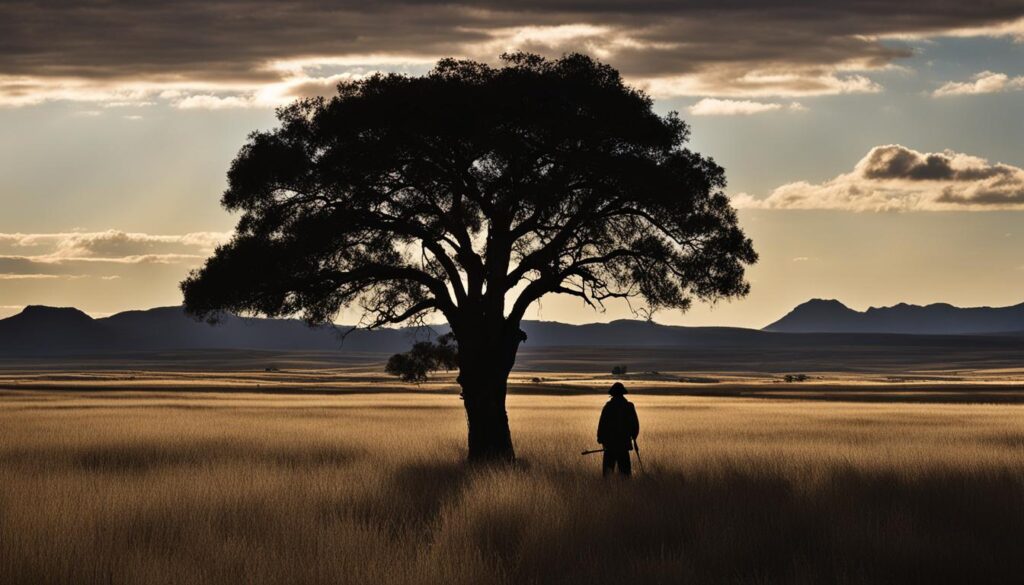
Land rights are not only significant for Aboriginal people but are also important for the broader Australian society. Recognizing and supporting Aboriginal land rights is an essential step towards reconciliation and building a more inclusive and equitable society.
The Ever-Evolving Nature of Aboriginal Identity
Aboriginal identity is a dynamic and ever-evolving concept that goes beyond static definitions. It encompasses personal experiences, cultural practices, and the deep connection to the community. Throughout one’s life, Aboriginal identity can be discovered, embraced, and celebrated in unique ways, reflecting the richness and diversity of indigenous culture.
Each individual’s journey of self-discovery contributes to the ongoing evolution of Aboriginal identity. It is not solely reliant on external factors but is deeply rooted in personal connections to land, family, and heritage. These connections shape the layers of identity, allowing it to expand and grow over time.
“Aboriginal identity is a captivating tapestry that weaves together historical roots, contemporary experiences, and the enduring resilience of indigenous communities.”
Central to the ever-evolving nature of Aboriginal identity is the recognition of cultural significance. Aboriginal culture is diverse and multifaceted, comprising unique traditions, spiritual beliefs, and artistic expressions. These elements continuously shape and transform the understanding of Aboriginal identity, both within the community and society at large.
The strength and resilience of Aboriginal people play a significant role in preserving and renewing their cultural heritage. It is through the transmission of knowledge and traditions from one generation to the next that Aboriginal identity thrives. The connection to ancestral lands, language, and storytelling is a testament to the enduring significance of indigenous culture.
Image:
The Evolution of Aboriginal Identity
The evolution of Aboriginal identity is a reflection of the dynamic nature of indigenous culture. It is shaped by historical events, experiences of colonization, and ongoing efforts to reclaim and celebrate Aboriginal heritage. While external factors may influence the perception of Aboriginal identity, it is ultimately defined and embraced by Aboriginal individuals themselves.
The process of self-identification is deeply personal and goes beyond a static definition. It incorporates elements of spirituality, connection to the land, family ties, and cultural practices. Aboriginal identity is a profound expression of self and community, fostering a sense of belonging, pride, and cultural continuity.
As Aboriginal people continue to navigate the complexities of identity, recognition, and self-empowerment, it is essential for society to respect and honor the ever-evolving nature of Aboriginal identity. This includes providing space for self-definition, promoting cultural inclusivity, and acknowledging the cultural significance of indigenous communities.
| Key Aspects of the Ever-Evolving Aboriginal Identity | Cultural Significance | Personal Experiences | Community Connection |
|---|---|---|---|
| Definition | Varies based on cultural practices and traditions. | Shaped by historical events, societal influences, and personal journey. | Fostered through interaction, shared values, and heritage. |
| Continuity | Preserves and celebrates Aboriginal culture and heritage. | Reflects the resilience and strength of Aboriginal individuals. | Strengthens bonds within the community and promotes cultural sustainability. |
| Growth | Expands through the recognition and inclusion of diverse cultural expressions. | Responds to individual, social, and historical factors. | Nurtured through community support and cultural revitalization efforts. |
Recognition and Acceptance of Aboriginal Identity
The recognition and acceptance of Aboriginal identity are of utmost importance, as they play a vital role in preserving and celebrating the rich cultural heritage of Aboriginal people. Understanding and acknowledging their unique identity is key to fostering inclusivity and creating a society that values diversity.
Aboriginal identity is defined by a three-part framework that encompasses descent, self-identification, and acceptance by the community. This definition recognizes the importance of ancestral connections, individual self-perception, and the validation and support of one’s community.
“Aboriginal identity is a fusion of our past, present, and future. It is rooted in the deep connection we have with our land, our traditions, and our fellow Aboriginal brothers and sisters. It is a journey of self-discovery and acceptance, one that is shaped by our shared experiences, our cultural practices, and our collective resilience.” – [Insert Aboriginal Elder Name]
This comprehensive understanding of Aboriginal identity allows for a more inclusive and respectful approach to engaging with Aboriginal individuals and communities. It enables us to honor and acknowledge their unique cultural contributions and recognize the significant role they play in shaping the fabric of Australian society.
Recognizing and accepting Aboriginal identity is not only a legal and moral imperative but also a means of celebrating the richness and diversity of Indigenous culture. By embracing and affirming Aboriginal identity, we pave the way for greater cultural understanding, reconciliation, and the preservation of a heritage that has endured for thousands of years.
Complexities and Controversies Surrounding Aboriginal Identity
The topic of Aboriginal identity is one that carries a great deal of complexity and often sparks controversy. Within indigenous communities, there are different perspectives and ongoing debates about self-identification, which can create tensions and disagreements. However, it is important to remember that Aboriginal people have the right to define their own identity and that their connection to their culture and heritage is what truly matters.
Identity is a deeply personal experience, shaped by cultural practices, individual experiences, and a sense of belonging to a specific community. This is no different for Aboriginal individuals, who may have varying degrees of connection to their indigenous communities and cultural traditions. Some may have traditional names, speak indigenous languages fluently, and have strong ties to their ancestral lands. Others may have grown up disconnected from their culture due to various historical and societal factors.
“Our connection to our culture and heritage is what defines us as Aboriginal people. It is not about meeting certain criteria or fitting into preconceived notions of what it means to be Aboriginal. Our identity is about our continued cultural practices, our stories passed down through generations, and our resilience in the face of adversity.” – Mary Smith, Aboriginal Elder
It is important to recognize and respect the diversity within the Aboriginal community and to avoid making assumptions or imposing narrow definitions on individuals. Aboriginal identity is not solely determined by blood quantum or physical appearance. It encompasses a deep cultural significance that goes beyond superficial classifications.
Understanding and appreciating the complexities of Aboriginal identity is crucial for building positive relationships and fostering a more inclusive society. By valuing and respecting the individual experiences and self-determination of Aboriginal people, we can all contribute to a more harmonious and culturally enriched Australia.
| Complexities and Controversies Surrounding Aboriginal Identity |
|---|
| The concept of Aboriginal identity is complex and often sparks controversy. |
| There are different perspectives and ongoing debates about self-identification within indigenous communities. |
| Aboriginal people have the right to define their own identity. |
| Connection to culture and heritage is what truly matters. |
| Identity is a deeply personal experience shaped by cultural practices, individual experiences, and a sense of belonging. |
| Recognize and respect the diversity within the Aboriginal community. |
| Aboriginal identity is not solely determined by blood quantum or physical appearance. |
| Understanding and appreciating the complexities of Aboriginal identity is crucial for building positive relationships and fostering inclusivity. |
Further Reading:
- “Navigating Identity: The Complexities of Aboriginal Self-Identification” – A study exploring the diverse experiences and perspectives of Aboriginal individuals in defining their identity within modern society.
- “Respecting Aboriginal Culture: A Guide to Cultural Awareness and Sensitivity” – A resource highlighting the importance of understanding and respecting the cultural diversity within Aboriginal communities.
Challenges Faced in Recognizing Aboriginal Identity
Recognizing and acknowledging Aboriginal identity can be a complex process, influenced by various factors such as legislation, government policies, and differing interpretations. These challenges often stem from inconsistencies in definitions and protocols that organizations use to confirm Aboriginality.
Government legislation and policies play a significant role in shaping the recognition of Aboriginal identity. However, the multiple interpretations and varying definitions can create barriers and difficulties in establishing a clear and inclusive framework.
In some instances, these protocols and requirements can unintentionally offend those who already have a strong sense of their Aboriginal identity. By placing the burden of proof on individuals, it may disregard the inherent emotional connection and cultural significance of their Aboriginality.
Efforts are being made to address these challenges and create a more inclusive approach to recognizing Aboriginal identity. While legislation and policies continue to evolve, it is essential to prioritize cultural understanding, respect, and self-identification within the Aboriginal community.
The Role of Legislation and Government Policies
Legislation and government policies play a crucial role in defining and recognizing Aboriginal identity. They lay the foundation for understanding Aboriginal rights, cultural heritage, and the legal framework for establishing native title and land rights.
“Government legislation and policies shape the recognition of Aboriginal identity, but the interpretation and implementation can vary, creating inconsistencies and complicating the process.” – Aboriginal Legal Service
However, these legislative frameworks can sometimes be limited in their capacity to capture the nuanced aspects of Aboriginal identity, resulting in challenges and controversies.
The Need for Inclusion and Cultural Sensitivity
Recognizing Aboriginal identity requires a commitment to inclusivity, cultural sensitivity, and an understanding of the diverse experiences and histories of Indigenous communities. It is vital to acknowledge that Aboriginal identity goes beyond a set of criteria or quantifiable measurements.
To address these challenges, organizations and institutions need to adopt more culturally sensitive approaches to establishing Aboriginal identity. These approaches should prioritize self-identification and community acceptance while respecting the cultural nuances and individual journeys that contribute to Aboriginal identity.
The Path to Inclusivity
Efforts are underway to bridge the gaps and ensure inclusivity in recognizing Aboriginal identity. Collaborative initiatives between Indigenous communities, government entities, and organizations are striving to develop frameworks that foster a deeper understanding of Aboriginal culture, heritage, and identity.
By fostering dialogue, embracing diversity, and prioritizing Aboriginal perspectives, we can create an environment that accurately recognizes and appreciates the rich tapestry of Aboriginal identity.
| Challenges | Impact | Solutions |
|---|---|---|
| Inconsistent definitions and interpretations | Lack of clarity and understanding | Promote dialogue and collaboration to establish clear and inclusive frameworks |
| Protocols and requirements | Barriers to self-identification | Emphasize cultural understanding and respect for individual journeys of Aboriginal identity |
| Limited legislative frameworks | Difficulty in capturing nuanced aspects of Aboriginal identity | Continuously evaluate and update legislation to reflect the complexities of Aboriginal identity |
Identity as a Personal Choice
Identity is a deeply personal choice, even for individuals of mixed Aboriginal descent. Choosing to identify as Aboriginal or not is an individual decision, influenced by cultural connection, personal experiences, and a sense of belonging. Respect and understanding for each individual’s choice is essential.
Aboriginal identity is not solely determined by bloodline or ancestry; it goes beyond genetic heritage. It encompasses a cultural connection to the land, a shared history, and a sense of belonging to the Aboriginal community. This cultural connection plays a significant role in individuals’ self-identification, as it shapes their experiences, values, and worldview.
One’s personal experiences greatly influence their choice to identify as Aboriginal. These experiences may include involvement in cultural practices, participation in community events, and exposure to Aboriginal traditions and values. They contribute to a sense of belonging and create a strong cultural connection that influences an individual’s self-identification.
“My Aboriginal identity is something that I hold dear to my heart. It’s not just about my family history; it’s about the cultural practices I grew up with, the stories passed down through generations, and the sense of community that I feel when I connect with other Aboriginal people. It’s a personal choice, but it’s also a way of honoring my heritage and preserving our cultural traditions.”
Respecting each individual’s choice to identify as Aboriginal or not is crucial. Society must recognize that Aboriginal identity is deeply personal and should not be questioned or invalidated. By acknowledging and accepting the diverse ways in which individuals express their Aboriginal identity, we can foster a more inclusive and harmonious society.
The Importance of Self-Identification
Self-identification is a fundamental aspect of Aboriginal identity. It allows individuals to reclaim their heritage, acknowledge their connections to the land, and assert their cultural rights. It is a way of asserting one’s Aboriginality and affirming their place within the Aboriginal community.
Self-identification also plays a crucial role in redressing the historical injustices faced by Aboriginal people. It allows individuals to reclaim their identities after years of cultural suppression and discrimination. By self-identifying as Aboriginal, individuals can assert their rights and advocate for the recognition of their culture, heritage, and contributions to society.
In conclusion, Aboriginal identity is a personal choice influenced by cultural connection, personal experiences, and a sense of belonging. It is essential to respect and understand each individual’s choice to self-identify as Aboriginal or not. By valuing and supporting diverse expressions of Aboriginal identity, we can create a more inclusive and accepting society that honors and celebrates the richness of Indigenous culture.
The Need for Respect and Understanding
The issues surrounding Aboriginal identity highlight the importance of respect, understanding, and empathy. It is essential to acknowledge and validate Aboriginal people’s ability to define their own identities without judgment or questioning. Respecting their cultural heritage and self-identification is crucial for fostering inclusivity and building positive relationships.
“Respect for the inherent dignity, culture, and heritage of Indigenous peoples is fundamental for achieving reconciliation and promoting social harmony.”
Aboriginal identity holds immense cultural significance and is deeply intertwined with the heritage and traditions of Indigenous communities. Recognizing and appreciating this significance helps create a society that values diverse perspectives and promotes equality. It is through respect and understanding that we can embrace and mutually learn from the rich tapestry of Aboriginal culture.
Respect for Cultural Significance
Aboriginal identity is not just an individual characteristic but a collective expression of cultural significance. It encompasses a profound connection to the land, the custodianship of traditions, and the maintenance of ancestral knowledge. By respecting the cultural significance of Aboriginal identity, we acknowledge and honor the unique contributions Indigenous communities make to society.
Preserving Heritage and Ensuring Respect
Preserving Aboriginal heritage is crucial for maintaining cultural diversity and promoting social cohesion. Aboriginal people have a deep-rooted connection to their ancestral lands, which plays a vital role in shaping their identity and well-being. Recognizing this connection and supporting land rights are essential steps toward fostering respect and protecting cultural heritage.
Nurturing Inclusivity through Understanding
Building inclusive communities requires understanding the experiences, histories, and struggles faced by Aboriginal people. By listening to their stories, acknowledging historical injustices, and advocating for change, we contribute to a society that values diversity and promotes equality. Respect and understanding encourage dialogue, empathy, and collaboration, thereby strengthening relationships and fostering unity.
Conclusion
Exploring the concept of Aboriginal identity allows us to uncover the rich complexities, challenges, and deep cultural significance of Indigenous people in Australia. Understanding the historical and societal factors that have shaped Aboriginal identity is crucial for creating inclusive practices and fostering respect for cultural diversity.
Embracing and celebrating Aboriginal identity is not only a matter of recognition but also a necessary step towards reconciliation and the strengthening of the fabric of Australian society. It requires us to actively engage with Indigenous culture, heritage, and traditions, recognizing their resilience and the profound connection they have with the land.
By promoting inclusive practices that uphold the rights and dignity of Aboriginal peoples, we can create a society that respects and values their unique contributions. The preservation and celebration of indigenous culture ensure the cultural richness and diversity that make Australia so unique, fostering a more vibrant and inclusive nation for all.
FAQ
What is an Aboriginal?
An Aboriginal refers to the Indigenous people of Australia, including both Aboriginal and Torres Strait Islander peoples. They have a rich cultural heritage and are the traditional custodians of the land.
What does Aboriginal mean?
Aboriginal is an adjective that describes anything related to or associated with the Aboriginal people of Australia, their culture, customs, and traditions.
How do you define Aboriginal people?
Aboriginal people are the Indigenous people of Australia, including both Aboriginal and Torres Strait Islander peoples. They have a unique cultural heritage and a deep connection to the land.
What is the history of Aboriginal people in Australia?
The history of Aboriginal people in Australia is marked by invasion, colonization, and the displacement of Indigenous communities from their traditional lands. They have experienced immense hardships and discrimination but have shown resilience in preserving their culture.
How is Aboriginal identity defined?
Aboriginal identity is defined by a three-part criterion: having Aboriginal or Torres Strait Islander descent, self-identification as Aboriginal, and acceptance by the community. This definition is widely accepted but subject to ongoing debates and challenges.
What challenges do Aboriginal people face in defining their identity?
Aboriginal people often face challenges in defining their identity due to historical factors such as colonization, racism, and the diversity of opinions within the community. These factors can create confusion and uncertainty about personal identity.
Why is cultural connection important for Aboriginal identity?
Cultural connection plays a vital role in Aboriginal identity. It is not solely determined by skin color but by a shared experience, cultural practices, and a deep connection to the land. Aboriginality encompasses a set of rules rooted in respect for the natural world.
How does Aboriginal identity intersect with education?
Aboriginal identity intersects with education through the experiences of Indigenous students who often face a clash between dominant white culture and their Aboriginal identity. Inclusive practices and programs are essential for promoting educational participation and success among Aboriginal students.
What is the impact of Aboriginal identity on health?
The impact of Aboriginal identity on health is significant. Historical and ongoing disparities in healthcare have affected the well-being of Aboriginal people. Resilience and the connection to cultural practices play a role in promoting health within Aboriginal communities.
How is Aboriginal identity linked to land rights?
The connection to the land is foundational to Aboriginal identity. Land rights issues have been central to the fight for Aboriginal rights and the recognition of their status as traditional custodians. The struggle for land rights is closely tied to the preservation of Aboriginal culture and identity.
Is Aboriginal identity a static concept?
No, Aboriginal identity is not a static concept, but rather an ever-evolving one. It is shaped by personal experiences, cultural practices, and one’s connection to the community. Aboriginal identity can be discovered, embraced, and celebrated throughout one’s life.
Why is recognition and acceptance of Aboriginal identity important?
Recognition and acceptance of Aboriginal identity are fundamental to the preservation and celebration of Aboriginal culture. It acknowledges the cultural significance of Aboriginal people and fosters inclusivity and respect within society.
Why is Aboriginal identity a topic of controversy?
Discussions around Aboriginal identity can be controversial due to differing perspectives and ongoing debates about self-identification. The diverse opinions within the community and external factors can create tensions and challenges in defining Aboriginal identity.
What challenges exist in recognizing Aboriginal identity?
Recognizing Aboriginal identity can be challenging due to inconsistencies in definitions and interpretations. Organizational protocols and requirements can create barriers and offend those who already have a strong sense of their Aboriginal identity. Efforts are being made to address these challenges and ensure inclusivity.
Is identifying as Aboriginal a personal choice?
Yes, identifying as Aboriginal is a personal choice, even for individuals of mixed Aboriginal descent. It is influenced by cultural connections, personal experiences, and a sense of belonging. Each individual’s choice should be respected and understood.
Why is respect and understanding important for Aboriginal identity?
Respect and understanding for Aboriginal identity are crucial in fostering inclusivity and building positive relationships. Respecting their culture, heritage, and self-identification is essential for recognizing and preserving the cultural significance of Aboriginal people.
